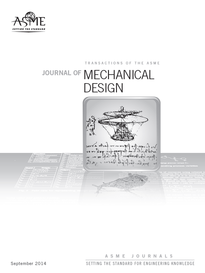About
WELCOME FROM THE EDITOR-IN-CHIEF

The ASME Journal of Mechanical Design (JMD) serves the broad design community as the venue for scholarly, archival research on all aspects of the engineering design activity. JMD has traditionally served the ASME Design Engineering Division and its technical committees, but it welcomes contributions from all areas of design with an emphasis on design synthesis. JMD embraces interdisciplinary design research topics and encourages submissions from teams of interdisciplinary researchers who work on theories and methods to support the design of emerging engineered products and systems. JMD communicates original contributions, primarily in the form of research articles of considerable depth, but also technical briefs, design innovation papers, book reviews, review articles on research topics or history of engineering design, and editorials. Topics within the scope of the journal include, but are not limited to:
- Design automation, including design representation, virtual reality, geometric design, design evaluation, design optimization, data-driven design, artificial intelligence in design, simulation-based design under uncertainty, design of complex systems, design of engineered materials systems, shape and topology optimization, engineering design for global development, ergonomic and aesthetic considerations in design methodology, and design for market systems;
- Design of power transmission systems, with an orientation towards interdisciplinary research on design and optimization of such systems and with an emphasis on new emerging techniques and novel mechanisms;
- Design education;
- Design of energy, fluid, and power handling systems;
- Design innovation and devices, including design of smart products and materials;
- Design for manufacturing and the life cycle, including design for the environment, DFX, and sustainable design;
- Design of mechanisms and robotic systems, including design of macro-, micro- and nano-scaled mechanical systems, machine and robotic components, and machine system design;
- Design theory and methodology, including creativity in design, decision analysis, preference modeling, user-centered design, design cognition, entrepreneurship and teams in design, design prototyping, and design synthesis.
Diversity and Inclusion The Technical Committee on Publications and Communications endorses the commitment of ASME to support diversity and to create and ensure inclusive and ethical practices for publishing as well as the science and engineering professions.
This website is a communication forum for the design community, and is a companion to the ASME Journals Digital Submission site. We provide more information about the journal, its scope, practices, and philosophy; short biographies of the editorial board that serves our authors; featured articles; and a list of frequently asked questions (FAQs). We continue to update the site based on your input. Welcome to the JMD community!

Editor-in-Chief:
Carolyn Conner Seepersad, University of Texas at Austin
Editor, Mechanisms:
Qiaode Jeffrey Ge: Stony Brook University
History: The Journal of Mechanical Design was originally published as the Journal of Mechanisms, Transmissions, and Automation in Design
(ISSN: 0738-0666) from 1983-1989.
ISSN:1050-0472
eISSN:1528-9001
CODEN:JMDEDB
Frequency: Monthly
Impact Factor: 3.300 (2022)
Five-Year Impact Factor: 3.800 (2022)
ASME Journal Program: JMD Editor Video
View Masthead
View Editorial Board Profiles
ASME Design Engineering Division
Diversity Equity & Inclusion (DEI)
The editorial board of the Journal of Mechanical Design (JMD) endorses the commitment of ASME to support diversity and to create and ensure inclusive and ethical practices for publishing as well as the science and engineering professions. Over the past few years, JMD has continuously expanded the geographic and gender diversity of its editorial board, with 31% of its current editorial board being women or from underrepresented groups. JMD has championed and implemented the double-blind review option to promote objectivity in the review process and reduce bias based on the authors’ country, gender, and seniority. In addition, JMD has reached out to underrepresented groups, young researchers, and women to feature as JMD webinar organizers and speakers. For suggestions to further improve the journal’s DEI practices, please contact JMD Editors (Professor Carolyn Conner Seepersad and Professor Qiaode Jeffrey Ge).T


